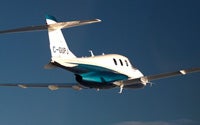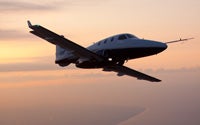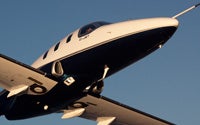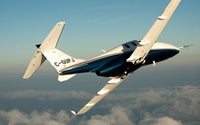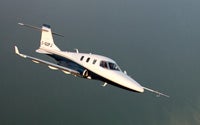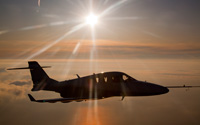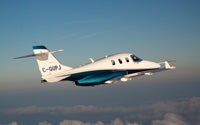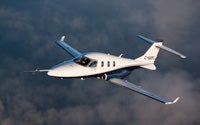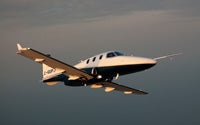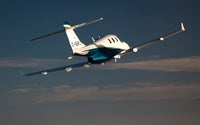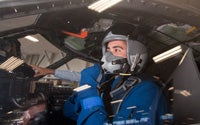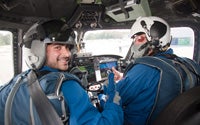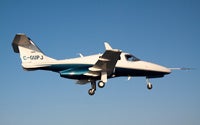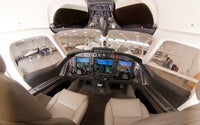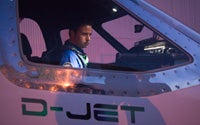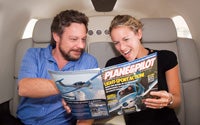The Single-Engine Jet From Diamond
I want one. And if you’re thinking about stepping up to your first jet in the next few years, you will, too, once you fly it.
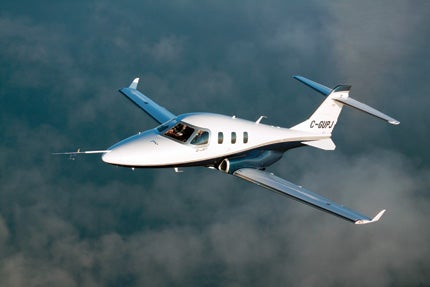 I want one. And if you're thinking about stepping up to your first jet in the next few years, you will, too, once you fly it. The Diamond D-Jet, which Diamond Aircraft is developing as its flagship product, represents what's likely to be the first Part 23, FAA-certified, single-engine, turbofan-powered jet in aviation history---the first to market in a segment coveted by many companies.
I want one. And if you're thinking about stepping up to your first jet in the next few years, you will, too, once you fly it. The Diamond D-Jet, which Diamond Aircraft is developing as its flagship product, represents what's likely to be the first Part 23, FAA-certified, single-engine, turbofan-powered jet in aviation history---the first to market in a segment coveted by many companies.
Why do I want one? Four reasons: It's fast, efficient, easy to fly, and has great ramp presence. It's the perfect first jet to get an aspiring jet owner/pilot up and cruising in the flight levels at speeds above 350 mph.
On the day of my test flight, I was to fly serial number 003, the most recently built of Diamond's three test planes. S/N 003 conforms aerodynamically to the production version, and thus, has almost identical performance to the future production aircraft. It's your typical experimental flight-test airplane, with the interior replaced by flight-test equipment and instrumentation. Additionally, due to the test nature of the D-Jet, Transport Canada (the Canadian equivalent of the FAA) requires that all flight crew wear a parachute and the full suite of survival gear.
 I've had my eye on the D-Jet since Diamond announced the program three years ago, and I wasn't going to pass up an opportunity to fly it. So when Diamond President Peter Maurer asked, "Do you mind wearing a flight suit, helmet, oxygen mask and parachute?" I responded, "Sign me up!" without hesitation.
I've had my eye on the D-Jet since Diamond announced the program three years ago, and I wasn't going to pass up an opportunity to fly it. So when Diamond President Peter Maurer asked, "Do you mind wearing a flight suit, helmet, oxygen mask and parachute?" I responded, "Sign me up!" without hesitation.
I suited up for the flight and then met with Diamond's experimental test pilot, Mark Elwess, who briefed me on the test area and general operating procedures for the test plane. After our preflight briefing, we walked out to the plane, did our preflight inspection and strapped into the D-Jet. Though it's not outfitted with a production interior, the cockpit was quite comfortable, with more than adequate forward and side visibility while sitting on the ground. After we completed our before-engine-start checklist, Elwess instructed me to turn the engine switch from "Off" to "Start"---pretty simple. At ground idle, the Williams International FJ33-5A engine was burning 84 pounds per hour, or about 12 gph at 24.7% N1. After we got the engine started, we taxied out to runway 15 at London, Ontario's airport. The weather for our flight was perfect: light winds out of the south, scattered cumulus clouds and a ground temp of 20 degrees C.
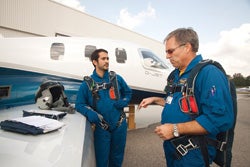 Cyrus Sigari (left) and Diamond's Mark Elwess (right) prepare to fly Diamond D-Jet S/N 003. Because the aircraft is still in the testing stage, Transport Canada requires all flight crew to wear a parachute and full suite of survival gear. |
As I pulled up to the runway, I was instructed by Elwess to push the takeoff configuration button prior to calling the control tower. This button is pushed just prior to takeoff to ensure that the aircraft is properly configured (flap and trim positioning) prior to departure. If the aircraft isn't configured properly, a CAS message is displayed on the MFD. If you forget to push the button before throttle up, then the system automatically will complete the checks and post the CAS message.
After I got my takeoff clearance, we lined up, and I smoothly advanced the single thrust lever to takeoff thrust, then quickly began accelerating down the runway. I began my rotation at 83 knots and broke ground about 2,500 feet down the runway. Shortly after liftoff, I trimmed out for an initial climb of 165 KIAS, climbing at 1,700 fpm and burning 850 pounds of fuel per hour.
The D-Jet's climb performance was impressive. Climbing through 16,000 feet, we were at 175 KIAS (235 KTAS) with a 1,300 fpm climb rate, and we were burning 588 pounds per hour at ISA+10 degrees C.
Due to airspace restrictions, we were limited to 20,000 feet, which is short of the D-Jet's 25,000-foot service ceiling. At 20,000 feet, I allowed the D-Jet to accelerate to a max forward speed of 307 KTAS, burning 523 pounds of fuel per hour, or 78 gph. With a day that was 10 degrees warmer than standard temperature, and 5,000 feet below the D-Jet's "sweet spot," the aircraft was already outperforming initial performance targets.
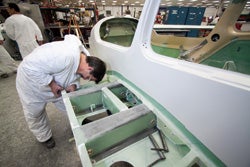 The Diamond D-Jet is being built and assembled in the same London, Ontario, facility as other Diamond aircraft such as the DA40. |
After hitting max cruise, I slowed the D-Jet to evaluate its handling qualities through a series of slow-speed to high-speed accelerations with the aircraft configured in various flap and gear configurations; no adverse or pilot-unfriendly conditions were evident. I was particularly interested in the D-Jet's slow-speed handling, and wanted to gauge how it would perform in the terminal area in the hands of a newly transitioning jet pilot. No surprises were encountered.
I also was curious to see how the D-Jet would fare during a 2-G steep turn at 60 degrees of bank. It may have been our speed, weight and atmospheric conditions---in any case, the D-Jet is the first jet I've flown that'll do a perfect steep turn with almost zero degrees pitch-up!
Diamond's legacy as a company that got its start producing motorgliders is clear and evident in the D-Jet. Coming out of 20,000 feet, Elwess demonstrated the jet's impressive glide performance. With power pulled to idle, the D-Jet's slick airframe and high-aspect-ratio wings kept us aloft for what would've been over 25 minutes, or an average descent rate of about 900 fpm. That's plenty of time to get an engine restarted in the unlikely event of an in-flight shutdown, or enough time to find an alternate landing spot if relight isn't an option.
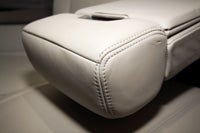 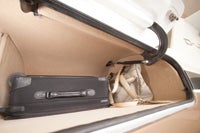 |
| The sleek airframe is complemented by a luxurious interior. Two exterior baggage areas offer ample storage, and the fold-down rear seats accommodate big items in the pressurized cabin. |
On our first landing, we planned to do a touch-and-go. Forward visibility during landing is excellent. With the flaps extended to the landing position, the deck angle changes by approximately seven degrees nose-down, as compared to the flaps-up position during straight-and-level flight. On our approach at an 85 KIAS Vref with power stabilized and on a three-degree glideslope, the sight picture of the beginning of the runway is directly in the center of the windscreen. This is a subtle, yet very important design feature of the D-Jet that offers its pilots a visually comfortable approach to landing.
Landing the D-Jet is a nonevent---cross the runway threshold at 50 feet, slowly bring thrust to idle, and wait for the plane to come home for a well-behaved landing. Currently, the test aircraft aren't equipped with the production trailing-link landing gear, which promises to provide pilots with even smoother landings.
As soon as the nosewheel touched down, Elwess retracted my flaps from landing to takeoff, and I applied full power, immediately accelerating back to our rotation speed and up for another circuit around the pattern. More of the same: stabilized on speed, in configuration for landing, thrust to idle at the approach end and smooth touchdown. As we pulled off the runway, I was convinced that the D-Jet was a solid machine.
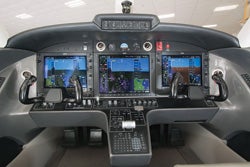 The D-Jet's G1000 avionics system offers the largest displays in the aircraft's category. |
As part of my introduction to the D-Jet, I had the opportunity to sit down and speak with Diamond COO Ken Harness. In addition to overseeing production at the London plant, Harness was tapped to directly oversee the design, certification, test and production of the D-Jet. From Harness, I learned what I had previously hoped to be the case: The D-Jet is a dirt-simple airplane---that's a really good thing. Diamond has employed one of the best airplane design practices out there, KISS ("keep it simple, stupid"), with incremental technological steps. Though Diamond took some technical risks in the certification of the D-Jet, it has done a great job of mitigating them.
Powered by a dual-channel, FADEC-controlled Williams International FJ33-5A medium-bypass turbofan engine, the D-Jet's engine control is as simple as it gets: a single thrust lever and a start switch. (The FJ33 also will appear on the D-Jet's single-engine competitor, the Cirrus Vision jet.)
One of the single greatest technical challenges Diamond has had to contend with, thus far, is its bifurcated engine duct design. Diamond made a significant commitment to making the D-Jet easy to fly by placing the engine's thrust line along the aircraft's vertical center of gravity. As a result, when thrust is applied or reduced, there's a relatively small, if any, change in aircraft pitch. Compare that to some of the other single-engine jet designs, in which the engines are placed above the aircraft center of gravity, sometimes requiring relatively complicated thrust-vectoring systems.
The cockpit ergonomics of the D-Jet are superb. Circuit breakers are hidden, yet easily accessed, beneath the outboard pilot and copilot armrests. The pilot and copilot audio panels are placed just forward of the outboard arm's resting location. The large GFC 700 autopilot control panel is centrally located on the glare shield. The FMS keypad used for entering flight plans into the G1000 is just beneath the inboard hand-resting position, adjacent to the single thrust lever. Diamond owners transitioning from a DA40 or DA42 will have an easy time finding their way around the D-Jet's cockpit.
The D-Jet has one of the most comfortable and ergonomic cockpits of the Garmin G1000--equipped jets currently in production, and it has the largest cockpit-screen layout, with two 12-inch PFDs and a 15-inch MFD.
Though the aircraft I flew didn't have a production interior, the mockup at Diamond's facility did have the final production configuration. Moving from the cockpit aft, you can't help but notice the width and height of the D-Jet cabin. The width behind the cockpit seats is as wide as a King Air 350 at just under 55 inches.
The D-Jet's aft seats are similar in size and comfort to those of a 7 Series BMW sedan, with bench seating for three. LED lights accent the sidewalls and the cabin. A work desk can be pulled up for the aft right seat. Sitting in the back seat, I could almost fully extend my legs without hitting the back of the pilot seats---a difficult accomplishment in most light jets.
The D-Jet truly is a "personal jet." It's not an overwhelming concept to own and operate this aircraft. Behind the D-Jet is a good company with a long-standing track record of producing good aircraft. Undoubtedly, there'll be challenges for Diamond to contend with as it marches toward certification (barring any future delays, Diamond expects to achieve this later in 2010) and production of its first turbine aircraft. Still, I feel confident in the company's ability to deliver the D-Jet to a market of hungry customers looking to step up to their first jet.
| Training With ATP |
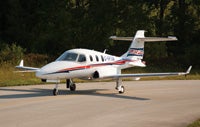 Airline Transport Professionals (ATP), one of Diamond's largest D-Jet customers, has been selected as Diamond's training partner in providing aircraft and simulator training to Diamond owners and operators. While flying for a commuter airline himself, ATP's president founded the school in 1984 in Atlanta, Ga., with just one airplane and an emphasis on providing fast-paced, low-cost ATP certificates for military and civilian commuter pilots. Airline Transport Professionals (ATP), one of Diamond's largest D-Jet customers, has been selected as Diamond's training partner in providing aircraft and simulator training to Diamond owners and operators. While flying for a commuter airline himself, ATP's president founded the school in 1984 in Atlanta, Ga., with just one airplane and an emphasis on providing fast-paced, low-cost ATP certificates for military and civilian commuter pilots.
ATP's reputation quickly spread by word-of-mouth referrals, and ATP opened more training centers and acquired more aircraft to meet the demand for high-quality multi-engine training. In 2006, ATP ordered 20 Diamond D-Jets that will, ultimately, provide training for D-Jet buyers and expand the school's ab initio training programs. ATP's programs include initial and recurrent training courses that use a combination of Level 6 FTDs and training in actual aircraft. Pilots can expect an approximate 3:2 ratio of FTD-to-airplane training. ATP has a history of training jet pilots, as it currently teaches in its CitationJet and Canadair Regional Jet simulators. The school has thousands of hours of hands-on experience working with pilots transitioning to jets. It knows what training techniques work best for the transitioning pilot, and its Citation and regional jet instructors understand the challenges specific to jet training. Over the years, ATP has used its jet-transition expertise to help thousands of pilots secure regional airline and corporate pilot positions---more than any other flight training school or academy. Visit www.atpflightschool.com. |
(click on image for full resolution picture)

Subscribe to Our Newsletter
Get the latest Plane & Pilot Magazine stories delivered directly to your inbox

